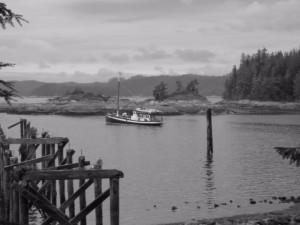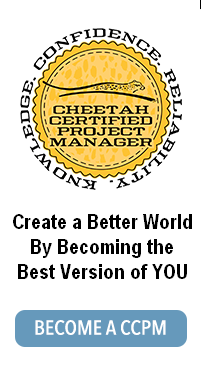Navigating Life’s Passages Using Project Management
Navigating Life’s Passages Using Project Management
By Michelle LaBrosse, CCPM, PMP®, PMI-ACP, Chief Cheetah and Founder of Cheetah Learning
I recently took a class to learn how to navigate the inside passage to Alaska. The class was held on a 65 foot rebuilt wooden 1929 boat with the original Diesel engine called the “David B.” This adventure originated because a colleague wanted me to help sail a 32 foot sailboat from Washington to Alaska to use for our corporate retreats. I realized doing this might require some unique skills so I sought out a class to get a handle on what would be involved in this pursuit.
The goal of the class was to get the David B 740 miles from Bellingham, Washington to Ketchikan, Alaska in twelve days. The speed the boat traveled was dependent on the capabilities that day of all the systems on the boat, the strength of the crew to be at sea, the wind, the tides, the currents of the various channels and passages, and any obstacles/distractions encountered enroute.
As with any project, the more experience the people on the project team had, and the quality of their tools, the more likely it was we would achieve our goal. And this was no different for the Inside Passage journey on the David B. What I realized in this class; for me to take a boat on the inside passage, I would need to assemble a crew with the skills and the experience to do so. While basic navigation skills for cruising the inside passage are required, they are just one of the skills required.
The projects that take you through life’s passages are just like navigating the inside passage – you might have some of the fundamental skills required, but success does ultimately depend on the strengths of your team, how you use those strengths, and the quality of the resources you assemble to achieve your goals.
Keep these five points in mind when navigating the important projects through your life’s passages:
A. Use qualified resources and know their capabilities and limits.
Through one of the rougher passages called Johnstone strait, I jotted a note in my navigation book – put the sailboat on a barge to ship it to Alaska. I knew that boat was not up for this trip. The boat is too small for big seas. To cruise across Johnstone Strait in that small sailboat would require waiting for the weather to be calm. This could be a long wait as the area has perpetual rough seas.
The same is true for any project. If you have the right tools and the right people (i.e. resources) achieving your project objective is possible. The reality of many projects though is people go into them without doing adequate due diligence of the resources required for the project. BEFORE undertaking a new project, evaluate what is required by studying how others before you have accomplished what it was they achieved. Also understand the capabilities and limits of those who will be involved. One of the students in our class suffered from sea sickness on rough seas. We could not travel as far on those days where the passages had rough seas.
B. Time the activity to go with the flow.
There is extensive documentation of tides and tidal currents. So going with the flow was a matter of being prepared (seems a bit of an oxymoron). Yet it’s the same with any project – knowing when it’s better to do some activities does take an awareness of the impact of the external environment. For example, people are pressed with lots of family responsibilities around the holidays so this is not the best time to require them to work long hours to meet a project deadline.
C. Know where the risky passages are and plan your way around them.
There are numerous narrow channels on the inside passage that actually have tidal rapids. You can only traverse these during slack times – some of them have slack times of just five minutes four times a day. When looking at the challenges for your projects, it makes sense to plot the path as well to know the best time and way to navigate the most challenging passages. Let’s say you are building a house and local building codes require an inspection to sign off on the work for code compliance. First make sure you do the work to code and next, find the times that are best for the inspector – work on making their life easier to make your life easier.
D. Make Mid-course corrections to account for changing conditions.
We anchored one night in a quaint protected and calm cove. When we came into the cove at 5 PM, it was relatively calm and at high tide. Since it had been a long travel day, we had planned to have a leisurely breakfast and pull anchor around ten am. As we were eating a late dinner, the tide was going out and we noticed all the exposed rocks at the inlet. We also heard the weather report of the sea swells starting around 2 the next afternoon right when we would be hitting an outside passage. We decided to leave five hours earlier at five AM to avoid any rocks at the inlet and to get through the outside passage in calmer seas. The same things happen on all projects – pay attention to those things that can make your life easier and change your plans accordingly.
E. Allow ample time for opportunities and challenges you encounter enroute.
Part of the fun of cruising the inside passage is seeing wildlife. But this most certainly cannot be planned. One afternoon we encountered a bear swimming across a cove. While we had seen a bear here and there on shore and slowed to get a better view, we took the time to stop and watch this. Another afternoon we ran into a very old salty dog guy on a very small sailboat stuck in an eddy current with a broken sail and out of gas. We were a hundred miles from anywhere so how he got that far on his boat was amazing. We were the first boat that stopped to help him.
We were both able to enjoy the swimming bear and help someone in need precisely because we built ample time into our schedule. The same is true for your projects. You can make working on your projects fun and meaningful when you factor in time to enjoy life along the way.
Learning how to better navigate the projects of your life using your innate strengths and the strengths of those around you can significantly enhance your journey as well. Learn how to chart your unique life path in the way that is best for you. Become a Cheetah Certified Project Manager –www.cheetahcertifiedpm.com



